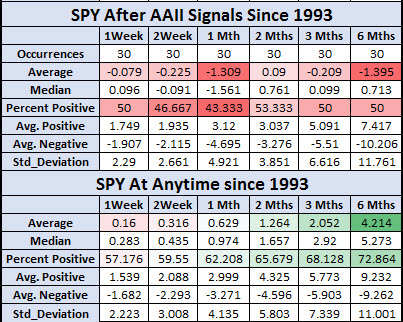Retail Bulls Hit the Bricks at Fastest Pace in Years
Just last week, one sentiment poll we follow showed active money managers reducing their stock market exposure atfever pitch, sending up a sentiment signal not seen in almost two years. Echoing that, the number of self-identified bulls in the latest American Association of Individual Investors (AAII) sentiment survey plummeted by the most since April 2013 last week. Against this backdrop, we decided to take a look at how the SPDR S&P 500 ETF Trust (SPY) tends to perform after bulls hit the bricks en masse.
AAII Bulls Flee
Specifically, AAII bulls nosedived by 15.8 percentage points in the week ended Wednesday, Nov. 15 -- the largest one-week drop in over four years, according to Schaeffer's Quantitative Analyst Chris Prybal. Most of those investors migrated to the bearish camp, with self-identified bears rocketing higher by 12.1 percentage points -- the most since the February 2016 lows. This is a sharp reversal from just two months ago, when we saw the biggest bear exodus in seven years.
Now, just 29.3% of AAII respondents consider themselves bullish, tying the lowest reading since early September. In the same vein, 35.2% of respondents are bearish, marking the highest point since the week ended Sept. 6. The number of self-identified "neutral" investors increased by 3.6 percentage points last week, to 35.4%, marking the highest since late September.
3 Signals Since 2009
There have been 31 of these massive AAII bull exoduses since 1994, but only three since 2009; most occurred as the dot-com bubble burst, right around the turn of the millennium. As such, the average SPY performance after these signals is ugly, with the fund in the red at every marker but the two-month slot. For instance, the SPY was down 1.3% and 1.4%, on average, one and six months after a signal, respectively, compared to anytime gains during those time frames, looking at data since 1993.


However, if you zoom in a bit, the returns aren't quite as scary. After the April 2013 bull exodus, the SPY went on a tear, rallying nearly 11% over the next six months. Prior to that, you'd have to go back to November 2010 for a signal, after which the SPY also surged more than 10% over the next six months. In fact, since 2003, there have been 14 other signals, and just two -- in early 2006 and in April 2008, during the financial crisis -- preceded six-month losses for the SPY. That's a win rate of 85.7%!
Likewise, the SPY averaged stronger-than-usual returns almost across the board, when looking at data since just 2003. Three months after a signal, the index was up 3.13%, on average, and was higher more than three-quarters of the time.

Climbing a Wall of Worry
In conclusion, it appears stocks continue to climb that "wall of worry," and until we hit the "euphoria" phase of the sentiment cycle, it's unlikely that a market top is imminent. Plus, if recent history is any indicator, the stock market could be flirting with record highs well into 2018.